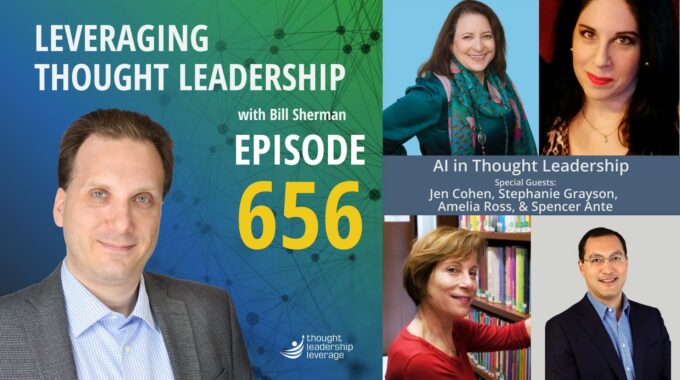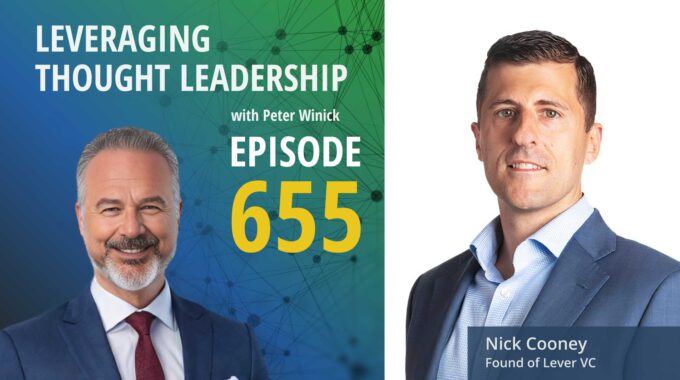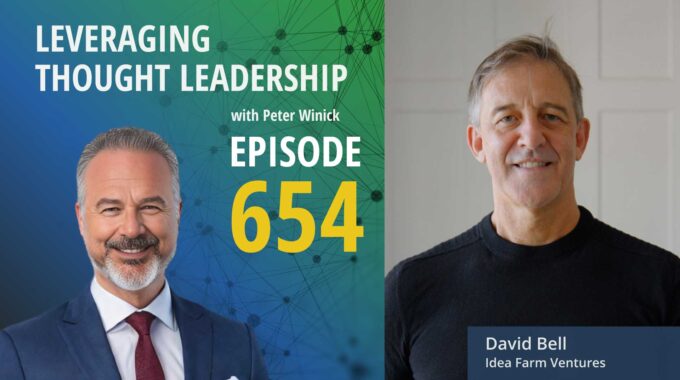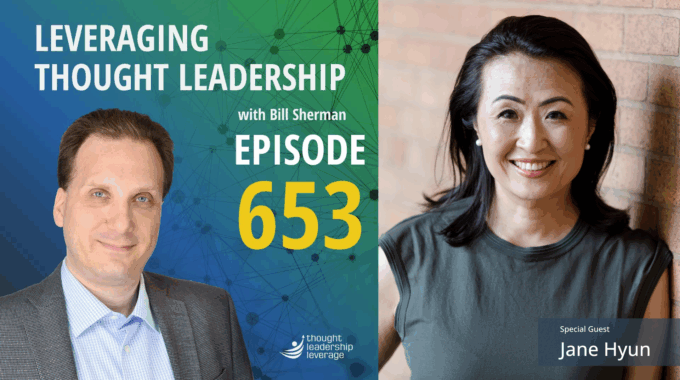Where Human Ingenuity Meets Machine Intelligence AI is transforming thought leadership—but not by replacing humans…
Aligning the Goals of Publisher and Author | Katie Anderson
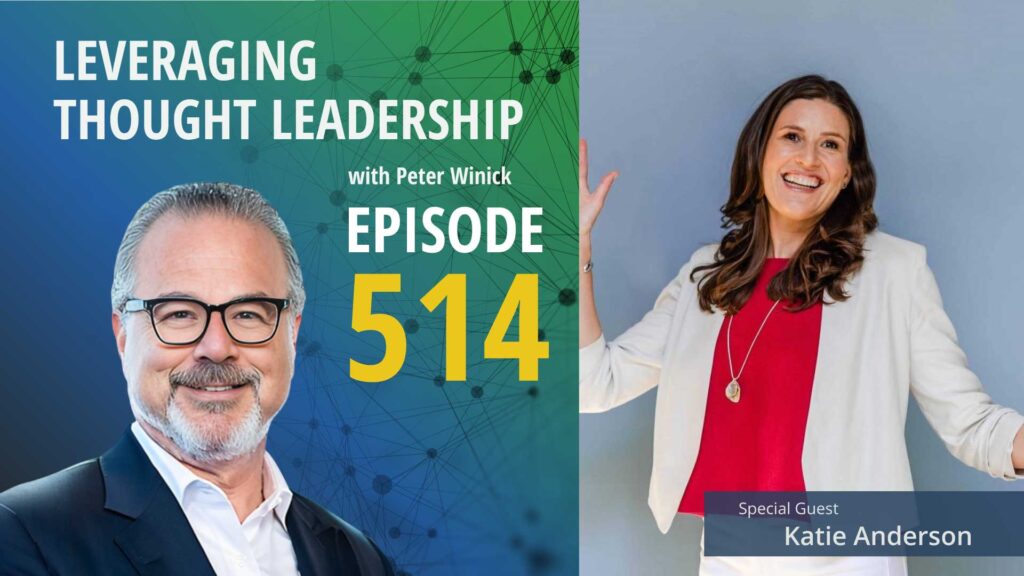
The impact a book can have, even after years on the market.
An interview with Katie Anderson about publishing a thought leadership book and the effects it has had on her business after three years.
Publishers often look at books as seasonal, but an author needs to look at their book as a long-term investment.
What should you be thinking of a year before publishing, and how can your book help your business – even years after it was released?
I’ve invited Katie Anderson, internationally recognized leadership coach, consultant, speaker, and founder of Katie Anderson Consulting to join me. At the time of this recording, Katie was celebrating the three-year anniversary of her book, Learning to Lead, Leading to Learn: Lessons from Toyota Leader Isao Yoshino on a Lifetime of Continuous Learning.
Katie’s journey into thought leadership literally took her around the world, from California to Australia and then to Japan, where she had the unique opportunity to partner with Isao Yoshino, a 40-year Toyota Motor Corporation leader. This time spent together became the fuel for her book, Learning to Lead, in which she weaves together Mr. Yoshino’s heartwarming and deeply reflective stories of personal discovery and organizational history, and offers her own unique perspective, with the intention of helping others learn to lead and lead to learn.
In the year leading up to publishing the book, Katie had a lot of big decisions to make. Katie shares how she was introduced to traditional publishers both big and small, but ultimately chose to self-publish. We learn the importance of having the goals of the publisher align with those of the author, and how an author can maintain control over the message and look of the book.
Now, three years after publishing, Katie shares the impact the book has had on her business and what she did to ensure it found its way into the right hands. She talks about sharing stories from the book and doing so from the heart, without a focus on selling units, but with a passion for the lessons that can be learned and the impact and value the book can have for others.
Three Key Takeaways:
- You need to have a full understanding of the purpose of your book. Allow that purpose to influence the choices around publishing, look, and feel.
- There needs to be complete alignment between a publisher and author. If you can’t find that perhaps another publishing method would better suit you.
- When self-publishing it is still important to hire professionals to do the work you are not good at. This will ensure a polished end product.
If you need a strategy to bring your thought leadership to market, Thought Leadership Leverage can assist you! Contact us for more information. In addition, we can help you implement marketing, research, and sales. Let us help you so you can devote yourself to what you do best.

Transcript
Peter Winick And welcome, welcome, welcome. This is Peter Winick. I’m the founder and CEO at Thought Leadership Leverage and you’re joining us on the podcast, which is Leveraging Thought Leadership today. My guest is Katie Anderson. She’s an internationally recognized leadership coach, consultant, author and speaker. In 2013, she founded Katie Andersen Consulting. She is a California native. She’s got a B.A. with honors from Stanford and was a Fulbright scholar in Australia. And she just recently published her latest book. So welcome aboard, Katie, which is learning to lead, needing to learn. So there you go. Cool. So why don’t we start with well, let’s start let’s start with how the hell did you get here? Like, this doesn’t seem like a linear path, and then we’ll get to. Oh.
Katie Anderson Well, it’s rare. It’s a linear path. And actually, even though it sometimes feels like my book was just published last week, at the time of this recording was the book’s three-year anniversary. So, it’s incredible. I’m no, you know, looking backwards, I see the common threads, but it wasn’t linear. I came out of university at Stanford thinking I wanted to be a Ph.D. professor doing research. And it wasn’t that.
Peter Winick Well, everybody comes out of Stanford.
Katie Anderson Still thinking they’re being academic. But I was a real nerd, a real learner at heart, and that’s where I started my career. You know, I was doing I was doing research at UCSF, the University of California, San Francisco. I’ve got my Fulbright. I did all of that research, very qualitative health policy based, which came to really help me in writing a book, later moved to Australia, stayed for four years because Australia was amazing in my late twenties, a place to be, and then came back to California, which is where I grew up, and took a role at Stanford Children’s Hospital in their performance improvement department. And that was there. Things really pivoted for me. I got very passionate about how do we create tangible change in organizations to make things better. And at that point, for, you know, for our patients who are small children in their families on that journey got really focused on the leadership behaviors around how do we be change? And ten years ago, I started my own consulting practice, Katie Andersen Consulting. And I really I work with change leaders in all different industries to really create cultures of learning and continuous improvement around the world. And then serendipitously, which has led to my book for my husband’s job in 2015, we moved to Tokyo, Japan, and I couldn’t have been more thrilled to go to the birthplace of the Toyota production system and Japan, which is the foundation of so much continuous improvement and Kaizen And that through that is where I met the subject of my book is Alyokhina, who’s a 40 year. So that was sort of the long journey. And now I’m back working with organizations around the world to create transformative cultures of learning. So there you go. But the path between learning international lives and connecting with people is the thread that unites it.
Peter Winick All right. And it’s always interesting to see where that thread come, because it, in your case, took a literally, literally a trip around the world and back and then that. Right. So speaking of journeys, writing a book is a journey. And even though yours is celebrated, I love the idea of book of nurseries, right? Like people celebrating the birthday of a book or something. But tell me a little bit about, you know, go back to maybe six months a year before the book was released, when you were making decisions about the how not necessarily the content per se, but lots of decisions to make. Self-Publish, hybrid, publish, go for the big house, whatever. What path did you go and why?
Katie Anderson Yeah. So to even go back like two years before, that’s where I got the book. And I just knew it was sort of like I wanted to create a book with Mr. Yoshino and share leadership lessons. And there’s a whole we can talk separately about the whole process of writing a book because that’s a whole nother thing. But it was years of purposeful interviews, leveraging my experience and qualitative research and then starting to write the book concurrently. I was also thinking about how do I bring the book to market and to publish it and all of that. So was working on the book, doing my consulting, and also thinking about how do I, you know, what’s the right process. So where I started was probably a probably a year before the book came out, actually, because it’s a long process to do the editing and getting the book to market. I talked to a lot of different authors in my space of business transformation, cultural improvement. I can take a group and talk to them about their experience from folks who were, you know, had traditional publishers and, you know, had successfully done books that way to others who had done a combination and others had only self-published.
Peter Winick And let me pause you there for a minute, because I love that. And what I find is maybe 5% of people actually do that because being an author is typically lonely. It’s a little bit introverted, but I think sometimes people don’t realize, like, geez, I’m not the first one to do this, to make these decisions, to go forward, to go, you know, to be overwhelmed. Why would I not talk to people that have done it before just to get that insight, good, bad or ugly? Right. And so many people don’t. And it’s shocking to me because I think. And you. You probably agree that when you reach out to folks and say, hey, I’m where you were five years ago, whatever, we’d love to hear about your experience. People are so open and welcoming and willing to share.
Katie Anderson Absolutely. And, you know, so, yes, you leverage your network to get information. We don’t create mistakes and we learn from different experiences. So I’m always happy to talk to aspiring authors about my game is really interested in coming here today to also share some of my experience and lessons learned. And everyone’s situation is different. And I always goes back to what’s your purpose and what’s your goal in writing the book because that will help you. It helps influence the decisions that you make about the process to get there. And you know, I might make different choices now as a more established author versus three or four years ago, when I had never published a book, I published my master’s thesis and yeah, which is a totally different world. So where I came to is that what was driving me as my purpose as an author was I wanted, of course, to create impact and wanted people to read the book and get value from it. But I also wanted to retain some control on how what the process looked like. I had some vision for some of the formatting of the book and I didn’t want, you know, I so I had some vision on that. Where it came down to also was what the process of getting a traditional publisher. Once I got introduced to a few of them, it seemed like it was going to be a still a multi-year process for having to. I had to write a whole pitch to them and a whole marketing proposal, and I was just ready at that point. This was were probably the nine-month mark to really like, get going to like.
Peter Winick So stay there a minute. I want to unpack two things you said. So, one is the goals, right? So, if the goals are to get the book out and show the world that you have it respected to kind of buy your ideas, etc., etc., great, right. Or whatever your goals are to elevate the brand to drive net new business. There’s lots of different goals. Then you have to have a timeline against those goals, right? And then you have to have alignment. And then that timeline. I think people don’t realize that if you’re going to go traditional publisher, first of all, I think you have to put it the other way. Why would they possibly choose you? Right? And I don’t mean that facetiously, but what is it that they’re looking for? Because if you put your goals on a piece of paper in theirs, their goals are really easy. You make more money selling the books than it cost them to produce the books. That’s their goal. You know, your goals are, you know, the amount of money that you make directly from a book is almost a rounding error. Even from all the books that you’ve sold relative to your business, I doubt it’s 10% of your revenue. So, there’s a lack of alignment with the publisher.
Katie Anderson Absolutely. And so I think at this point I would have different opportunities because I’ve established myself as a bestselling author. I’ve won my books by multiple awards, including a very prestigious award in my space called the Chicago Publication Award. It’s been translated into six languages and more coming, so I’ve really established myself as a sellable author.
Peter Winick If you’re enjoying this episode of Leveraging Thought Leadership, please make sure to subscribe. If you’d like to help spread the word about our podcast, please leave a five-star review at ratethispodcast.com/ltl and share it with your friends. We’re available on Apple Podcasts and on all major listening apps as well as at Thought Leadership Leverage.com/podcast.
Peter Winick So when you think about the disconnect from an alignment standpoint between your goals and the traditional publisher’s goals and why what they’re looking for and what you’re looking for, it was probably out of sequence at the time for you as a first-time author to go traditional, right?
Katie Anderson Absolutely. And it’s you know, they want to have a lot of information for you from you and like your marketing plan. And, you know, at this point, being a well-established author, I’ve demonstrated I can sell books. I’ve received some really special awards, including the single publication award, and my books been translated into multiple languages, would be a different taste of me going to a traditional publisher now. But as a first-time author, I also was like, Oh, this, this is going to be a really laborious process. Even get in the door. Now, I did have some introductions to some smaller, more news publishers in the in the space, and I ultimately decided and I had some offers from them and I ultimately decided not to go that route, not that that was a bad route, but for me, as we say, aligned with my goals, I really wanted to retain more control over, over the book that and go down that journey because that so, you know, I just decided that what they were offering me I would be able to create by establishing my own publishing company, hiring the people to do the books. You know, I think self-publishing often gets you know, people think you’re just like dupe slapping up a word document onto.
Peter Winick Yeah, right, right.
Katie Anderson People are really.
Peter Winick I know. I think the old school self-publishing look like, you know, the fourth-grade class project or something. And today, there’s no excuse for anything less than, you know, perfection and professionalism in terms of the look and the field and all that. And I think the other advantage that you sort of alluded to is time. It takes time to write a book, takes time to edit a book. Those things take time. But the time to market can be accelerated when you’re self-publishing and you have more control. If you have a vision for layout, look, feel, cover, all these other things, you don’t answer anybody.
Katie Anderson Absolutely. And I like to say that, you know, instead of saying I self-published, like I said, I established a publishing company and the same way that I have other businesses and I hired people to do the professional jobs, to publish professional level books. And so I just have to do it. You know, it’s interesting. People say, help me work. Do you think your publisher is going to say about that? And I’m like, Well, I can introduce you to the publisher. I’m like, Hello, Right? Yeah, we could actually have made things a lot easier. I’m the one who decides what to say yes to the, you know, the international contracts. I was just talking to a large corporation who wanted, you know, some customized books to give out as gifts at a cup coming out. And they’re like, What do you think your publisher would say about that? I’m like, Well, we can. It’s an easy process. Let’s get this going. So exactly. A lot of benefits to that, you know, going that route, you know. But I also highly recommend authors that you hire people who have skills in this because the learning, the process of all you need professional editors to navigate all of these publication platforms because it’s just you don’t want to keep making the same mistakes. There’s no reason for you to take make those mistakes or stumble through it when you can hire people to help you through that process.
Peter Winick Exactly. So now talk about, you know, it’s been three years what the book has done, and I don’t necessarily care about it in terms of number of units sold, that sort of thing. But what’s the before and after and the impact that has had on the business? Because that’s really the point.
Katie Anderson Yeah, right. Absolutely. So, you know, I think there’s there were a few fourth goals. Like I genuinely felt this was a passion project of amplifying Mr. Yoshida’s lessons and wisdom into the world in the same way that I had the value of being able to sit by his side for years. But also there was, you know, of course you want it does happen by all your thought leadership and so forth as it relates to the business. And in continuing the impact though, that you want for your business also requires it’s not just publishing the book, but it’s continuously and relentlessly marketing and publicizing the book and getting it in the hands of people, because otherwise you’re not having that impact.
Peter Winick So stay there for a second because I think that’s a critical piece. So when you go a traditional publisher or a hybrid publisher, publishers think in terms of publishing cycles. That’s a fall release or spring release, whatever the case may be. As a business owner, you don’t care. When the book was published, like you’re spending time every day thinking about how do I get this book in front of these people that line up to the types of clients that I’d like to serve and get it in front of them, because that’s a great conversation starter, a great way for them to get exposed to them. To our way of thinking and what we do. Right. And that doesn’t that clock doesn’t run out at 90. Okay?
Katie Anderson No, no. It’s a lot of work and effort in, you know, some even traditional published authors said like honestly your book publisher isn’t doing a lot of the marketing for you. It’s really it’s on the author too, to really take the leadership on that. And so I saw that first year and I also I published in July of 2020, so height of the lockdown. So I just went on so many podcasts and webinars and just putting things out there. It was just important. And I like I really believed in the message in my book. So it was like that talking from the heart, not just trying to sell books, but really amplify the stories that I felt just so grateful to be able to, to put out there and continue in continuing to build on that and then building things in my business that supported because the stories in the book are not my stories, but I’m the one who shaped them. And there I can take those stories and apply them through the consulting and coaching that I do. So I created and this is again during the pandemic, online coaching programs for individuals, and that then morphed into doing more corporate work. And now that person, my corporate work has expanded dramatically. And also all of my speaking engagements, which were, you know, remote for the first 18 months. And now I’ve been traveling around the globe. I’ve been to ten countries in the last year speaking on the pages, both about the book and then the messages and the ways that I help people take those messages and embody them. And so it’s been both a combination of building invisibility and work comes to me because people read the book, Right? Right.
Peter Winick And I think you move from the author role to the evangelist, which is pretty interesting. Interesting. So any final words you have for someone in a situation that you were in four years ago or words to your younger self, this is like a bad movie.
Katie Anderson Totally. So first, go back to purpose. What is your goal in? Your purpose of writing this book? The reason why it real. In many cases, the book really becomes your calling card. And it’s like I said, then how does it fit with your business and then align your publication process with those goals, right? And get the people to help you learn the things that you need to learn and help you with the things you don’t necessarily have the expertise in so that you can have the impact that you want. Some people just want to write a book, but if you really want impact with your book, it takes it’s a it’s a much longer journey and just that list and also be passionate about your topic because we’re going to be talking about it for a long time.
Peter Winick Yeah, and don’t get tired of it because the passion, you know, could wear out after you’ve been on the 70th podcast telling a similar story to a new population audience. Because every time you’re doing that, it’s somebody first. Right. So you have to be mindful that, well, this has been great. Appreciate your time, Katie. Thank you so much for coming on and sharing, sharing your journey. Appreciate it.
Katie Anderson Thanks, Peter. And people can reach out to me. Katie Anderson at CBJ Anderson dot com and on LinkedIn as well. So reach out and good luck everyone on your thought leadership and publication journey.
Peter Winick Thank you.
Peter Winick To learn more about Thought Leadership Leverage, please visit our Web site at ThoughtLeadershipLeverage.com. To reach me directly, feel free to email me at Peter at thoughtleadershipleverage.com and please subscribe to leveraging thought leadership on iTunes or your favorite podcast app to get your weekly episode automatically.


